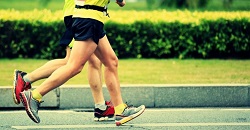The six most common running injuries (and how to treat them)
With the uptake of running gaining popularity, so has the injuries. It doesn't necessarily mean it's time to hang up your running shoes. Here are the most common running injuries you need to know about and how to treat them.

Sports and Exercise Medicine and Musculoskeletal Physician Dr Alastair Jones from the Sports Medicine and Injury Clinic talks to us about the six most common running injuries.
"Running has been gaining in popularity for several years now. During 2020 with the global pandemic and implementation of multiple lockdowns it became even more popular. A way of getting out and escaping for a period of time as well as keeping fit. As one might expect with more people running and at an increased frequency, running injuries have also increased! It is thought about half of all runners annually will pick up an injury of some description. Acute injuries such as muscle strains or falls leading to cuts, bruises and fractured bones occur, but are far less common than overuse or chronic injuries.
The term ‘overuse’ in terms of injury simply means doing something too frequently or at too high an intensity so that the body does not have time to adapt and a part of it breaks down. As a musculoskeletal and sports medicine physician I see this frequently when runners build their distance in order to compete in longer races (going from 10K to half marathons for example).
Chronic injuries can also be triggered by changing footwear, altering the surface run on or adapting/modifying running style. If the body is not use to the altered pattern of running, then it will fatigue, and injuries can follow.
Below is a brief run through of the more common chronic injuries that can plague runners and affect their ability to perform and enjoy the sport they love. This list is by no means exhaustive so seeking medical attention when you experience pain brought on by running is essential to ensure the correct diagnosis is made.
1. Plantar Fasciitis
The Plantar Fascia is a tough piece of connective tissue that runs from the toes to heel bone. It is crucial for the normal movement of the foot and ankle and it supports the arch on the inside of the foot. Plantar Fasciitis is a common cause of heel pain in runners and can be caused by any of the reasons listed in the introduction above as well as obesity and poor ankle flexibility.
It is a degenerative condition in which the tissue breaks down and can be associated with some inflammation. Runners presenting to a medical practitioner with this can expect a clinical evaluation to confirm the diagnosis and elicit the cause. This could be supplemented with investigations such as Ultrasound and MRI scanning. Treatment options include, Physiotherapy, Orthotics assessment, shockwave therapy, anti-Inflammatory medication and sometimes injections.
2. Achilles Tendinitis

The Achilles Tendon runs from the end of the calf muscles at the back of the lower leg to its insertion into the base of the heel bone. Inflammation of the Achilles Tendon either at its insertion or more commonly in its mid-substance, leads to pain at the back of the lower leg near the heel. Additional to the causes listed in the introduction, tight calf muscles can also lead to this condition.
Much like Plantar Fasciitis runners presenting to a medical practitioner with this can expect a clinical evaluation to confirm the diagnosis and elicit the cause. This could be supplemented with investigations such as Ultrasound and MRI scanning. Treatment options include, physiotherapy, orthotics assessment, shockwave therapy, anti-Inflammatory medication and sometimes injections.
3. Medial Tibial Stress Syndrome (“Shin Splints”)
Runners with “Shin splints” experience pain down the inside of the shinbone, usually nearer the bottom than the top. This is caused by inflammation to structures in this area. Runners complain of pain that builds during exercise and eases with rest. It is a direct result of high impact exercise overloading the tibia (e.g., running on concrete) along with certain predisposing biomechanical factors.
It is possible after clinical evaluation an MRI scan could be ordered to help delineate the diagnosis, your physician may also perform some blood tests to look at things such as calcium and Vitamin D. Treatment involves, rest, Physiotherapy to strengthen the lower limb and core, possible orthotics assessment and a careful, graduated reintroduction to running program.
4. Stress Fractures
A stress fracture is caused by repeated micro-trauma over time. Much like “Shin Splints”, runners complain of pain that builds during exercise and eases with rest (there may even be some pain at night). It is a direct result of repeated high impact exercise along with certain predisposing biomechanical factors. The common bones affected by stress fractures are the tibia, fibula, metatarsals and navicular (one of the small foot bones).
Diagnosis is confirmed with clinical evaluation and MRI scanning. It is also very likely blood tests will be needed to rule out other causes of stress fractures. Treatment includes rest and immobilisation for a period of time and then Physiotherapy to strengthen the lower limb and core, possible orthotics assessment, possible medical therapies if abnormalities are detected on blood tests and a careful, graduated re-introduction to running program.
5. Patellofemoral Pain Syndrome (“Runner’s Knee”)
This is pain around the front of the knee. A direct result of repetitive load in certain biomechanically pre-disposed people. It has multiple causes and careful clinical evaluation is needed to elicit the correct diagnosis. Some causes may need further investigation to help guide treatment. Treatment often involves Physiotherapy to strengthen lower limb and core muscles. It may also be necessary to obtain an orthotics assessment. Education about running technique and frequency is also essential. Occasionally certain injections can be performed.
6. Iliotibial Band (ITB) Syndrome
The ITB is a very strong piece of connective tissue that runs from the outside of the pelvis to the outside of the tibia below the knee. ITB Syndrome is inflammation resulting from the band rubbing against the lateral femoral condyle of the knee joint.
The pain around the outside of the knee builds during exercise and eases with rest. Sadly, ITB Syndrome can be persistent and has a habit of recurring after resolution. Diagnosis is usually made from accurate clinical evaluation and occasionally ultrasound or MRI scanning. Treatment options include Physiotherapy, anti-Inflammatory medications, and sometimes guided injections into the area to reduce inflammation. The runner often benefits from running education to help prevent recurring episodes.
Conclusion

There are multiple common overuse injuries that can affect runners. As with all injuries it is crucial to get an accurate diagnosis and treatment plan in order to return to running as safely and as speedily as possible."
To get to the bottom of your running injury, simply book an appointment with the Sports Medicine and Injury Clinic at Nuffield Health Leeds Hospital on: 0113 388 2067.
